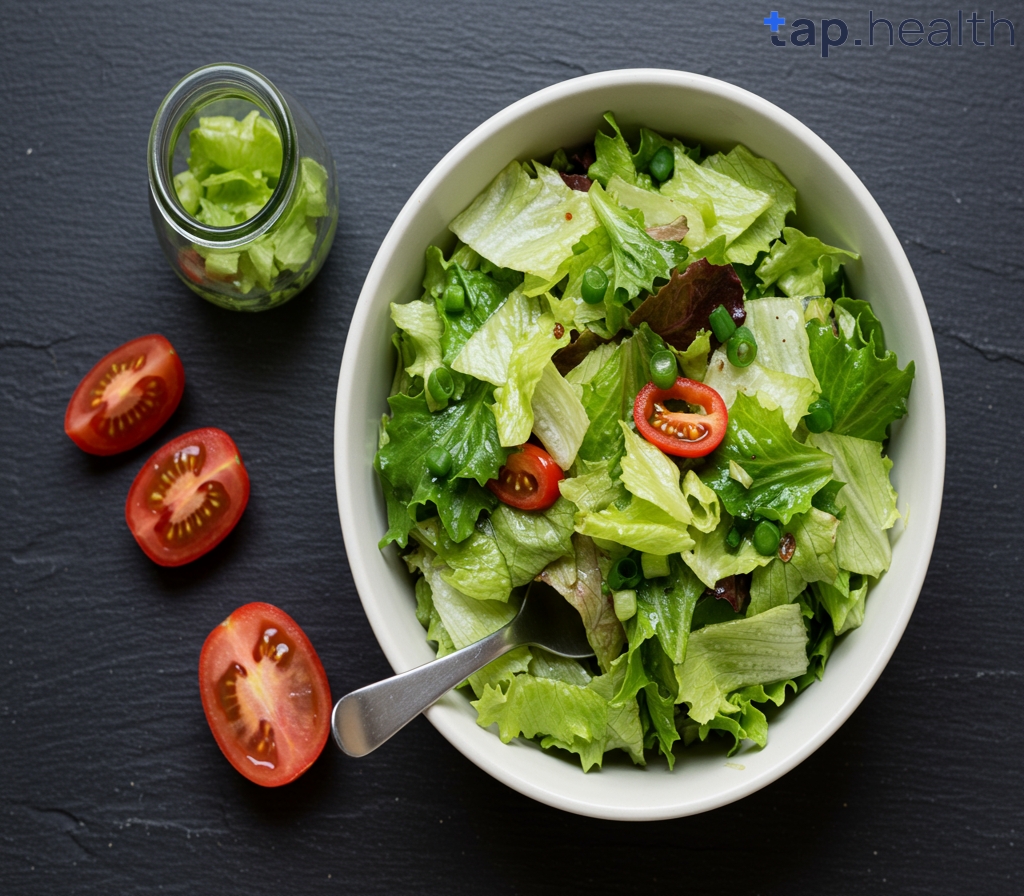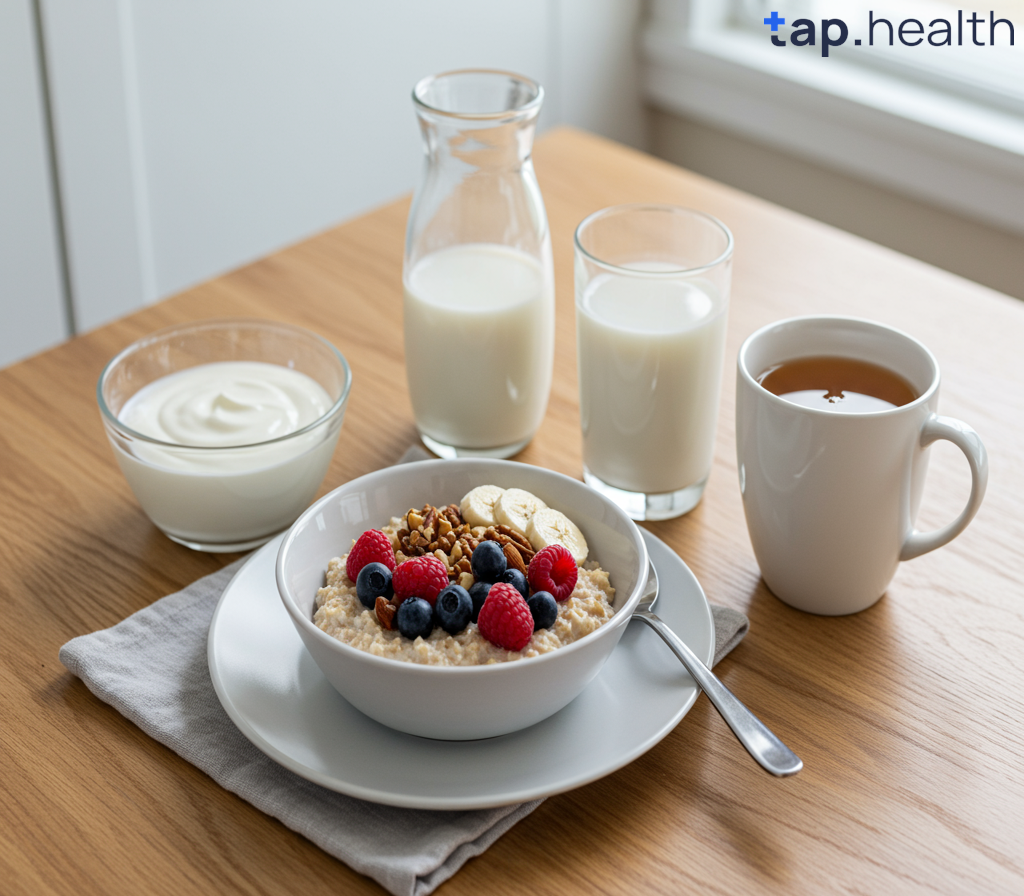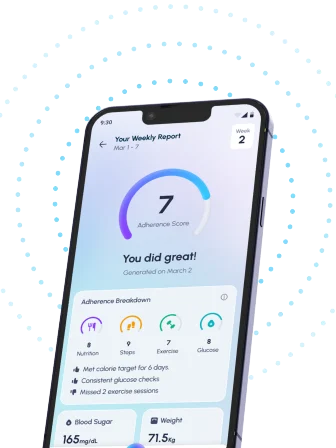Table of Contents
- Prebiotics & Probiotics: Your Gut’s Best Friend for Diabetes Management
- Boosting Gut Health with Prebiotics and Probiotics: A Guide for Diabetics
- What are the Benefits of Prebiotics and Probiotics for Blood Sugar Control?
- Prebiotics vs. Probiotics: Which is Best for Improving Diabetes Outcomes?
- Improve Your Gut Microbiome and Manage Diabetes Naturally with Prebiotics and Probiotics
- Frequently Asked Questions
- References
Living with diabetes often means navigating a complex world of dietary choices. But what if I told you a simple strategy could significantly impact your blood sugar levels and overall well-being? This blog post focuses on boosting gut health with prebiotics and probiotics: a diabetes focus. We’ll explore how these beneficial bacteria and their food sources can help regulate blood glucose, improve insulin sensitivity, and even reduce inflammation – all crucial aspects of managing diabetes effectively. Get ready to discover how a thriving gut microbiome can be your secret weapon in your diabetes journey!
Prebiotics & Probiotics: Your Gut’s Best Friend for Diabetes Management
Maintaining a healthy gut is crucial, especially for the significant portion of the population managing diabetes. Globally, a considerable number of people living with diabetes fall within the 20-64 age bracket (61%), highlighting the importance of proactive health management during peak working years. This is particularly relevant in Indian and tropical countries where dietary habits and lifestyles can significantly impact gut health and diabetes management.
Understanding the Gut-Diabetes Connection
The gut microbiome plays a critical role in blood sugar regulation. Prebiotics, essentially food for beneficial gut bacteria, and probiotics, live microorganisms, work synergistically to improve gut health. A balanced gut microbiome can enhance insulin sensitivity, improving blood sugar control. In tropical climates, incorporating regionally available prebiotics like fruits rich in fiber (mangoes, bananas) and fermented foods (idli, dosa) can be highly beneficial.
Actionable Steps for Better Gut Health
Incorporating prebiotics and probiotics into your diet is a simple yet powerful step. Consider adding foods rich in fiber, like legumes and whole grains, common in Indian cuisine, to your daily meals. Fermented foods, easily accessible in many tropical regions, provide natural probiotics. Remember to consult with your doctor or a registered dietitian to create a personalized plan that aligns with your specific needs and dietary preferences, especially considering the prevalence of diabetes within the 20-64 age group (61%) and the 65+ age group (39%). For more in-depth information on how to manage diabetes through gut health, read our article on Enhance Gut Health and Manage Diabetes with Prebiotics and Probiotics.
Boosting Gut Health in India and Tropical Countries
The availability of diverse fruits, vegetables, and fermented foods in India and tropical regions presents a unique opportunity to naturally support gut health. By focusing on these readily available options, you can significantly improve your gut health and contribute to better diabetes management. Prioritize a balanced diet, and remember that even small changes can make a big difference in your overall well-being. Maintaining a healthy gut also plays a vital role in boosting your immune system, which is particularly important for those managing diabetes. Learn more about this connection in our article, Boosting Immunity While Managing Diabetes.
Boosting Gut Health with Prebiotics and Probiotics: A Guide for Diabetics
Managing diabetes effectively often involves careful carbohydrate intake. For many, this means aiming for roughly 45–60 grams of carbs per meal, though individual needs vary. However, what we often overlook is the crucial role of gut health in managing blood sugar levels. A healthy gut microbiome, rich in beneficial bacteria, can significantly improve insulin sensitivity and overall metabolic health, making it an important ally in diabetes management. This is where prebiotics and probiotics step in.
Understanding Prebiotics and Probiotics
Prebiotics are non-digestible food ingredients that act as “food” for the good bacteria in your gut, promoting their growth and activity. Common prebiotic sources include many fruits and vegetables readily available in Indian and tropical countries, such as bananas, mangoes, onions, and garlic. Probiotics, on the other hand, are live microorganisms that, when consumed in adequate amounts, confer a health benefit. Fermented foods like yogurt (especially those containing live and active cultures), kimchi, and idli (a popular South Indian breakfast food) are excellent sources of probiotics.
Practical Tips for Diabetics
Incorporating prebiotics and probiotics into your diet is simple and effective. Start by gradually adding more prebiotic-rich fruits and vegetables to your meals. Pair them with probiotic-rich foods like yogurt or fermented vegetables to maximize the benefits. Remember to always check food labels for sugar content, as some commercially prepared yogurts can be high in added sugars. Consult with your doctor or a registered dietitian to create a personalized plan that aligns with your specific dietary needs and diabetes management strategy. For more information on dietary strategies to prevent diabetes, you might find our article on Pre Diabetic Diet Chart: Simple Plans to Prevent Diabetes helpful.
Boosting Your Gut Health, Naturally
Prioritizing gut health is a powerful step towards better diabetes management. By incorporating readily available prebiotic and probiotic rich foods into your diet – already staples in many Indian and tropical diets – you can naturally support your body’s ability to regulate blood sugar. Speak to your healthcare provider today to discuss how you can optimize your gut health for improved diabetes management. To learn more about the fascinating connection between gut health and your overall diet, check out our article: What’s the Connection Between Gut Health and Your Diet?
What are the Benefits of Prebiotics and Probiotics for Blood Sugar Control?
Maintaining healthy blood sugar levels is crucial, especially in regions like India and other tropical countries where diabetes is prevalent. Understanding the role of gut health in blood sugar regulation is key. Blood sugar levels less than 140 mg/dL are considered normal, while 140–199 mg/dL indicates prediabetes, and 200 mg/dL or higher suggests diabetes. This highlights the importance of proactive measures.
The Gut-Blood Sugar Connection
Emerging research strongly suggests a link between gut microbiota (the community of bacteria and other microorganisms in your gut) and blood sugar control. Prebiotics, non-digestible food ingredients that promote the growth of beneficial bacteria, and probiotics, live microorganisms with health benefits, play a significant role in this connection. A balanced gut microbiome can improve insulin sensitivity, aiding in the efficient processing of glucose and helping to maintain healthy blood sugar levels. For more information on prebiotics, you might find The Pros and Cons of Prebiotic Supplements helpful.
Practical Benefits in Tropical Climates
In hot and humid climates prevalent across India and other tropical regions, dietary habits often influence gut health. Including prebiotic-rich foods like bananas, onions, and garlic, common in many Indian dishes, can significantly boost the beneficial bacteria in your gut. Similarly, incorporating probiotic-rich foods like yogurt (especially those containing live and active cultures) and fermented vegetables can further enhance your gut health and contribute to better blood sugar management. These dietary changes can be easily integrated into existing culinary traditions. It’s also important to be aware of factors that might negatively impact blood sugar; for example, learn more about the potential effects of antibiotics by reading Do Antibiotics Increase Blood Sugar?
Actionable Steps for Better Gut Health
To improve your gut health and potentially support better blood sugar control, focus on a diet rich in prebiotics and probiotics. Consider incorporating these foods into your daily meals. Remember, consistent healthy eating habits are more effective than sporadic changes. Consult with a healthcare professional or a registered dietitian to create a personalized plan tailored to your specific needs and dietary preferences. This is particularly important if you have prediabetes or diabetes. Prioritizing gut health is an accessible and effective step towards managing blood sugar levels in India and other tropical countries.
Prebiotics vs. Probiotics: Which is Best for Improving Diabetes Outcomes?
Maintaining healthy blood sugar levels is crucial for individuals with diabetes, ideally keeping pre-meal levels between 80–130 mg/dL and post-meal levels under 180 mg/dL. Both prebiotics and probiotics play a vital role in gut health, impacting overall well-being and potentially influencing blood sugar control. But which is better for managing diabetes in the context of Indian and tropical climates?
Understanding the Difference
Prebiotics are non-digestible food ingredients that act as “food” for beneficial bacteria in your gut. Think of them as the fertilizer for your gut garden. They encourage the growth of beneficial bacteria, improving gut microbiome diversity. Common prebiotic sources prevalent in Indian and tropical diets include bananas, onions, garlic, and various legumes. These readily available foods can significantly contribute to improved gut health.
Probiotics, on the other hand, are live microorganisms (bacteria or yeasts) that offer health benefits when consumed. They are like introducing beneficial plants directly into your gut garden. Many fermented foods like yogurt (especially those with live cultures), kimchi, and idli, popular across India and other tropical regions, are excellent sources of probiotics. Including these in your diet can help bolster the beneficial bacteria population.
Which is Better for Diabetes Management?
The answer isn’t a simple “either/or.” Both prebiotics and probiotics contribute to a healthy gut microbiome, which research increasingly links to better blood sugar control in individuals with diabetes. A balanced approach, incorporating both prebiotics and probiotics into your diet, is likely the most effective strategy. Prebiotics provide the fuel for existing beneficial bacteria, while probiotics introduce new beneficial strains. The synergistic effect can lead to enhanced gut health and potentially better diabetes management. Understanding your carbohydrate intake is also crucial, and you might find our article on Low-Carb vs. Moderate-Carb Diets for Diabetes: What Works Best? helpful in this regard.
Actionable Steps for Improved Gut Health
For individuals with diabetes in India and tropical countries, focusing on a diet rich in locally sourced prebiotic and probiotic foods is essential. Incorporate a variety of fruits, vegetables, legumes, and fermented foods into your daily meals. Consult a healthcare professional or registered dietitian to create a personalized dietary plan that caters to your specific needs and health status. Remember, a healthy gut is a happy gut, and a happy gut can contribute significantly to overall well-being and diabetes management. If you’re concerned about prediabetes, you might also find our guide on How to Reverse Prediabetes? beneficial.
Improve Your Gut Microbiome and Manage Diabetes Naturally with Prebiotics and Probiotics
Did you know that up to 80% of Type 2 diabetes cases can be delayed or prevented through lifestyle changes? This startling statistic highlights the crucial role of preventative measures, and focusing on gut health is a powerful strategy, especially in regions like India and other tropical countries where diabetes prevalence is rising. A healthy gut microbiome, teeming with beneficial bacteria, plays a significant role in blood sugar regulation and overall metabolic health. By improving your gut health through prebiotics and probiotics, you can naturally support your body’s ability to manage diabetes. This is particularly relevant given the increasing burden of lifestyle-related diseases in our region.
The Power of Prebiotics and Probiotics
Prebiotics act as food for the beneficial bacteria in your gut, promoting their growth and activity. Think of them as the fertilizer for your gut garden. Foods rich in prebiotics include fruits, vegetables like onions and garlic (common in Indian cuisine), and whole grains. Probiotics, on the other hand, are live microorganisms that directly introduce beneficial bacteria into your gut. These are often found in fermented foods like yogurt, kimchi, and idli (popular in South Asia), as well as supplements. Regular intake of both prebiotics and probiotics can help improve insulin sensitivity, reduce inflammation, and improve blood sugar control.
Practical Tips for Better Gut Health
Incorporating prebiotic and probiotic-rich foods into your daily diet is key. Start by adding more fruits, vegetables, and whole grains to your meals. Experiment with traditional fermented foods from your region. Consider consulting a healthcare professional or registered dietitian before starting any new supplement regimen, especially if you have existing health conditions. Remember, managing diabetes effectively is a holistic journey, and nurturing your gut microbiome is a significant step towards a healthier, happier you. Prioritizing gut health is not just a trend; it’s a vital strategy for preventing and managing diabetes, particularly pertinent in high-risk populations across India and tropical regions. For more information on the connection between nutrition and gut health, check out this article: How Nutrition Impacts Gut Health and the Microbiome – Tap Health. And for additional tips on managing diabetes effectively, see our guide: 10 Proven Tips for Effective Diabetes Management.
Frequently Asked Questions on Prebiotics and Probiotics:
Q1. How can I improve my gut health to better manage my diabetes?
Improving gut health involves a two-pronged approach: consuming prebiotics (foods that feed good gut bacteria, like fruits, vegetables, and whole grains) and probiotics (live microorganisms found in foods such as yogurt and idli). A balanced diet rich in both, alongside a personalized plan from your healthcare professional, is most effective.
Q2. What are the benefits of using prebiotics and probiotics for diabetes management?
Prebiotics and probiotics work synergistically to improve insulin sensitivity and blood sugar control. A healthier gut also boosts immunity, contributing to better overall well-being for individuals with diabetes.
Q3. Are prebiotics and probiotics suitable for everyone with diabetes?
While generally beneficial, it’s crucial to discuss incorporating prebiotics and probiotics into your diet with a healthcare professional. They can help create a personalized plan that considers your specific health needs and any potential interactions with medications.
Q4. What types of foods are rich in prebiotics and probiotics, especially in tropical regions like India?
India and tropical regions offer readily available prebiotic-rich foods such as fruits, vegetables, and whole grains. Probiotic-rich options include fermented foods like yogurt and idli.
Q5. What is the role of a healthcare professional in managing diabetes through gut health?
A healthcare professional plays a vital role in developing a personalized plan that considers your individual health status and any potential interactions with medications. They can guide you on the safe and effective use of prebiotics and probiotics as part of your overall diabetes management strategy.
References
- A Practical Guide to Integrated Type 2 Diabetes Care: https://www.hse.ie/eng/services/list/2/primarycare/east-coast-diabetes-service/management-of-type-2-diabetes/diabetes-and-pregnancy/icgp-guide-to-integrated-type-2.pdf
- What is Diabetes: https://www.medschool.lsuhsc.edu/genetics/docs/DIABETES.pdf




